The 42-year-old battle with survival, sheer distress, justice, and life.
A nurse who medicated the ailing bodies, who pampered the stinging cries, couldn’t foresee the bed that was calling her. On November 27, 1973, a heinous episode left her blind-to not catch a glimpse of her tomorrow again, left her deaf-to not get wind of her own screams, and left her paralyzed- to not hug the independent life she had been living, ever again. For 42 years! I repeat, for 42 years!
Aruna Ramchandra Shanbaug, the Indian medic, who worked as a junior nurse at the Kings Edward Memorial Hospital in Mumbai, was ruthlessly assaulted and raped by a ward boy. For there is more- the abuse cut off blood and oxygen supply to crucial parts of her brain, consigning her to blind, deaf and paralyzed for the rest of her life.
The rhythm of wedding bells could be heard as she was planning to get married to Dr Sundeep Sardesai in the same year, in December. But that one beastly night overruled her fate of well-being and changed her life for the worse. While everybody’s life around her went on, as usual, hers came to a harsh dead end. She never literally lived again.
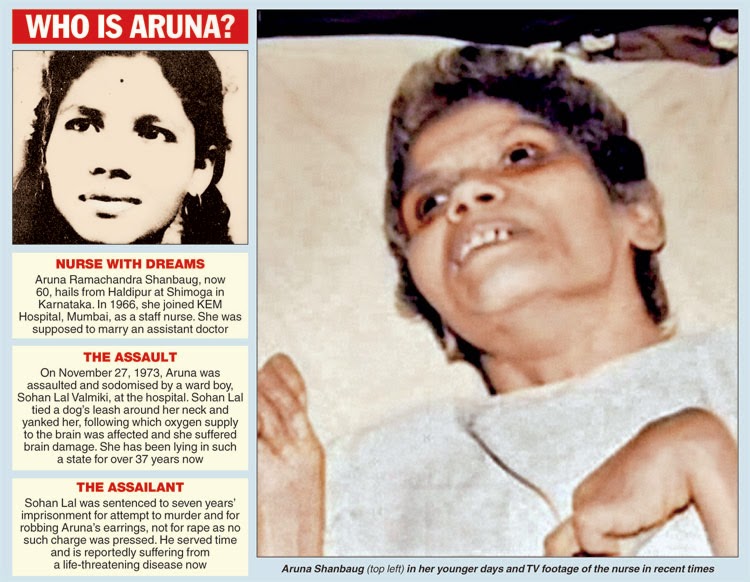
Now, remember, this was 1973. Rape as a matter of concern, as a headline, and as a crime was screened. It was in the dark. Clouded enough to not come in view of the public eye; for, it stigmatized the women. As for anal sexual intercourse, forget it. And thereby, the Dean of KEM Hospital settled not to publicize the confirmation of the monstrous crime on Aruna Shanbaug. The authorities weren’t heartless enough to cement the case entirely! The gold chain and engagement ring, which her assaulter Sohanlal Valmiki stole from her after the aggression, were used as evidence to charge him with the secondary crime of attack ad robbery. Commendable!

The usually modest and soft-spoken young nurse had condemned the ward boy for stealing food meant for the hospital’s dogs. So how did he exactly retaliate? He choked her with a dog chain and sodomized her. This inhuman act of his led to asphyxiation, which interrupted oxygen to her brain, terminating brain stem swelling injury and cervical cord injury. She was found the next morning, lying on the floor unconscious, with blood-drenched all over. Although her eyes looked normal as if she lay with her eyes open, she could not even see a particle. Her cognitive powers were dissolved. Her limbs were movable yet she couldn’t walk. Aruna Shanbaug had dropped into a Persistent Vegetative State.
The history of Shanbaug’s living death has been reported and recorded in detail by many journalists, writers, and even poets who paid her visit over the years. The most obvious and well-known is Pinki Virani’s book- Aruna’s Story: The True Account of a Rape and its Aftermath, published 25 years after that iron lady skidded into PVS. There have been innumerable other descriptions of generations of nurses and doctors who responsibly took care of her as time passed by.

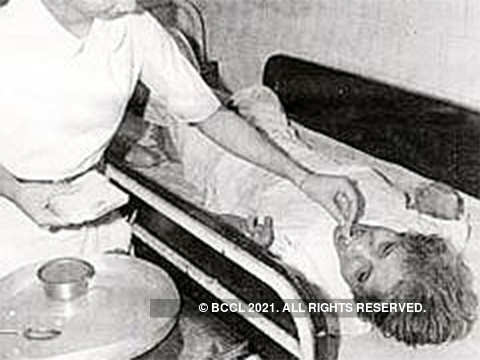
Her promising young life was smothered with a dog chain. And the accused who sodomised her in a dense hospital basement, and left her to die, walked out free of charge after spending just, and just seven years in prison. Meanwhile, she only kept dying every single day of her life for the next 42 years!
In the wake of the attack, nurses in Mumbai went on strike appealing for improved conditions for Shanbaug and better working conditions for themselves. Note, that images and approaches like sexual harassment at the workplace were not even identified back then. A woman’s authority to a secure and safe work environment didn’t even fall into any consideration. Position and pride were of principal concern and thus the cruelty of the outrage remained under wraps for a good while.
However, I have to mention this, to date, the prominence of the continuous efforts of the nurses who took care of Shanbaug hasn’t faded yet. As generations passed, new nurses took over and were rightly briefed about her eternal love for fish and mangoes. Colourful curtains were added to her room often and the music system would engulf her room every evening. After a point, her family completely abandoned her. Her fiance had moved on. But her colleagues paid her frequent visits according to their convenience.
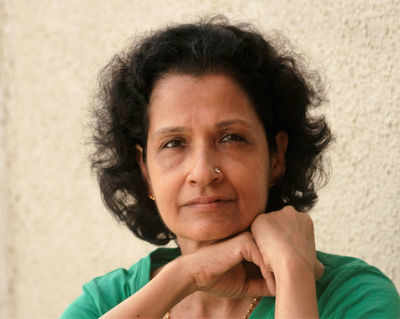
In the 1980s, the BMC made two almost successful attempts to move her out of KEM Hospital to free the bed she had been occupying for seven years. The hospital’s nurses did not let that happen. By the time Pinki Virani stepped in, a couple of decades had rolled by. She was dreadfully moved by Shanbaug’s condition. Her excerpt read-“Aruna Shanbaug is not blessed. She is partially brain dead. She is blind. She cannot speak. She has atrophying bones, and wasting muscles…She feels pain; this part of her brain is a sly survivor, it continues to be healthily alive. She gets her periods, these are excruciatingly painful periods.”
Virani penned down her book and also filed a petition in the Supreme Court of India on behalf of Shanbaug in 2009 appealing to legalize euthanasia. In March 2011, the court rejected the petition. However, in its historic judgement, it allowed passive euthanasia in the country but additionally ruled that this wasn’t applicable in Shanbaug’s case. The nurses who nursed her through the decades weren’t braced to let her go. She was alive in all senses for them. It was a gripping argument to keep her alive.
Shanbaug lay in her bed, ignorant of the world that pursued to move around her, uninformed of the battles fought in her name, for her sake. She developed into an exemplary symbol to whom distinctive people correlated in distinctive ways. To the nurses, she was a figure of hope. A hope that even if she doesn’t win back, their humanitarian stand would be justified in some way. Hope that, if anything like this happened to one of them, the others would stand strong around, rally around as they had done for Shanbaug. Generations of nurses nurtured her over for decades, talking to her, feeding her, singing to her, and crying for her because they rightfully addressed her as their family.
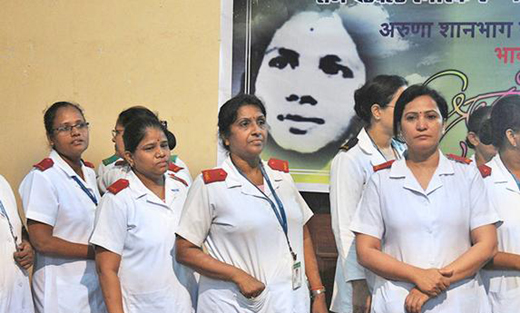
To others perceiving the state from the outside, she was a symbol of despair. A thorough reminder of other women who are animalized and convicted to a living death. To women’s rights activists, she was a symbol of the disaster executed by gender discrimination and sexual violence against women.
I wasn’t even born when the incident commenced circulating. I didn’t know her personally. I still do not. But after sucking up to all the articles in her name, after minutely staring at those helpless images captured back then, I don’t think I’d be wrong if I conclude that Shanbaug did not really yearn to be a symbol of anything. She was at the very edge of living a full life. Like me, she too would have wanted to have an independent adventurous life, a heart in need, a few opinions to stand by, and a job that promised her satisfaction.
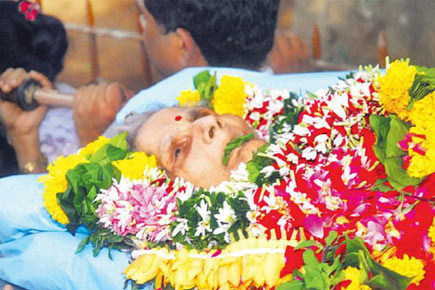
On May 18, 2015, when she took her last breath,, the debate boiled over once more. Would she have wanted to live like this? Would it not have been more humane to let her die? Even to help her die? There were heated arguments on both sides.
For me, one of the breathtaking impressions of Aruna Shanbaug’s story is the merciful assistance she received from her colleagues and the hospital where she lay for 42 years. Neither for fame, nor for money, but because it needed to be done. Imagine any of today’s lavish hi-tech hospitals showing this kind of empathy for one of their own. Heartfelt gratitude to Virani and her engagement with Aruna Shanbaug; in today’s date, we rightly have legalization that approves something many of us believe in: that a person is ought to be allowed to go without resistance and with serenity when life is no longer worth delaying.
Aruna Shanbaug, Pinki Virani, and the nurses of KEM all have given us some notable life examples that might never come our way again. Aruna Shanbaug’s legacy will see through for a long time.
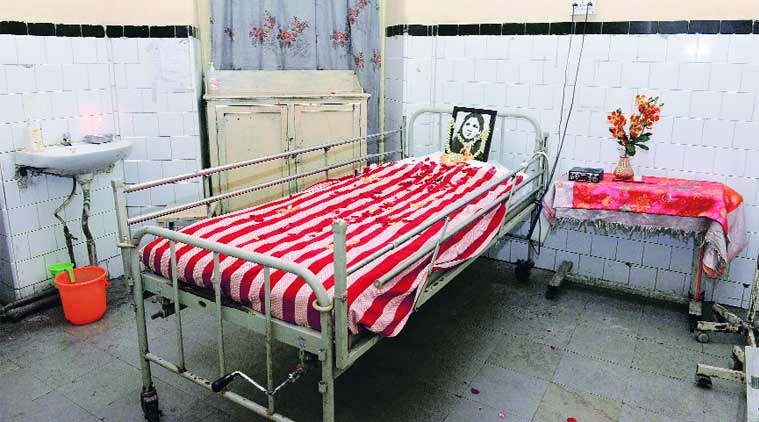
Shrestha S. Purkayastha
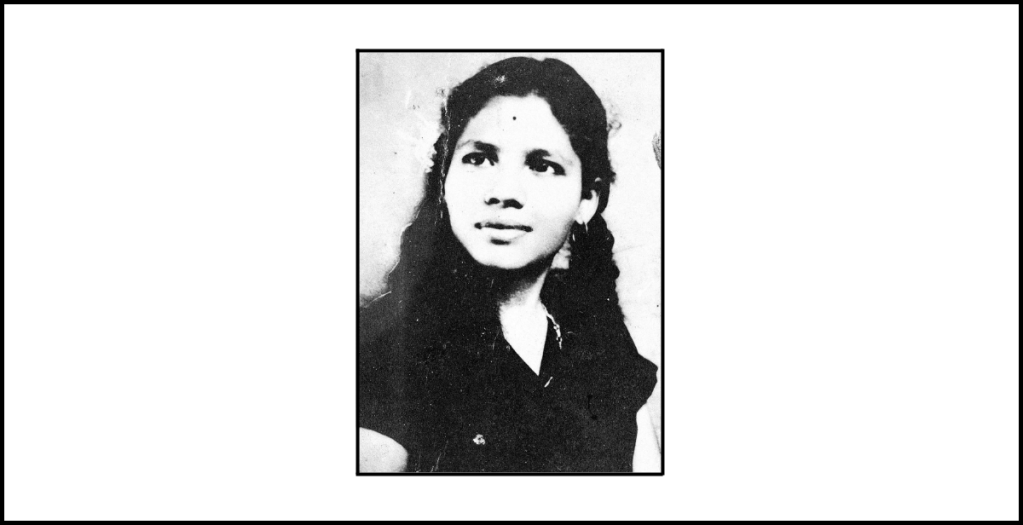
Leave a comment